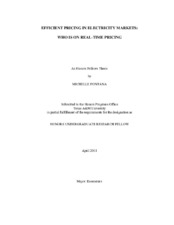| dc.description.abstract | When prices are set properly, they serve as important signals to guide customers to consume the efficient quantity of a good. However, in electricity markets many consumers do not pay prices that reflect the scarcity of power. The true social cost of power varies throughout a typical day; power is usually low cost during off-peak periods in the night but it is high cost during a hot July afternoon. Economists have argued for several decades that consumers should pay a price that varies with the true social cost of power. However, the vast majority of consumers pay a fixed price whether they use power at midnight or noon. This can create a host of economic inefficiencies.
Fortunately, this is beginning to change. In many states, including Texas, large commercial and industrial users of electricity pay prices that reflect the social cost of power at the time of consumption. This pricing mechanism is called “real-time pricing” (RTP) in electricity markets. I have access to a unique, new dataset of virtually all 8000 commercial and industrial users in Texas that includes information on both whether they pay real-time prices and their hourly consumption for one year. First, I econometrically
iv
estimate the types of commercial and industrial firms that are likely to “sign up” for time-varying prices. Second, I test whether the customers on real-time prices reduce demand substantially in response to higher prices. I find that customers with greater total hourly consumption are more likely to be on real-time pricing. Customers with more „peaky‟ load profiles are less likely to be on real-time pricing. Customers in south and west Texas have a greater probability of being on RTP than customers in Houston. I also study whether customers on RTP decrease consumption on hot summer days when electricity is scare. These results have important implications for the design of both deregulated electricity markets and policies that seek to increase the amount of electricity generated with renewable sources of energy. | en |


